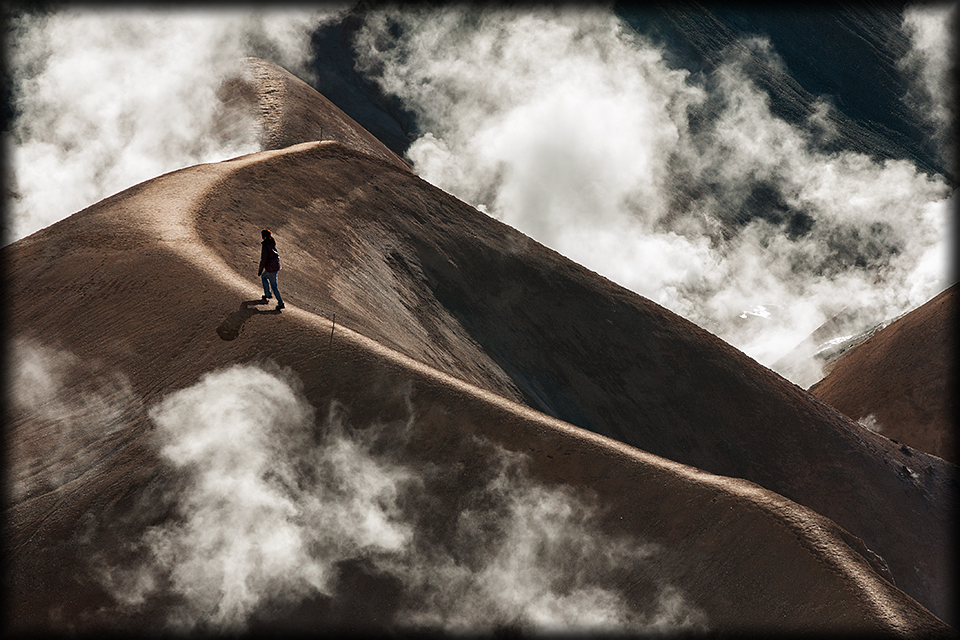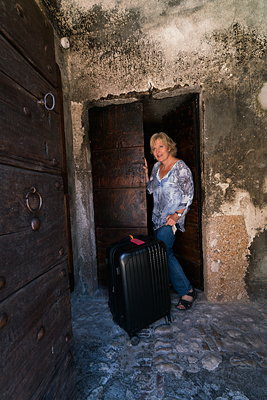
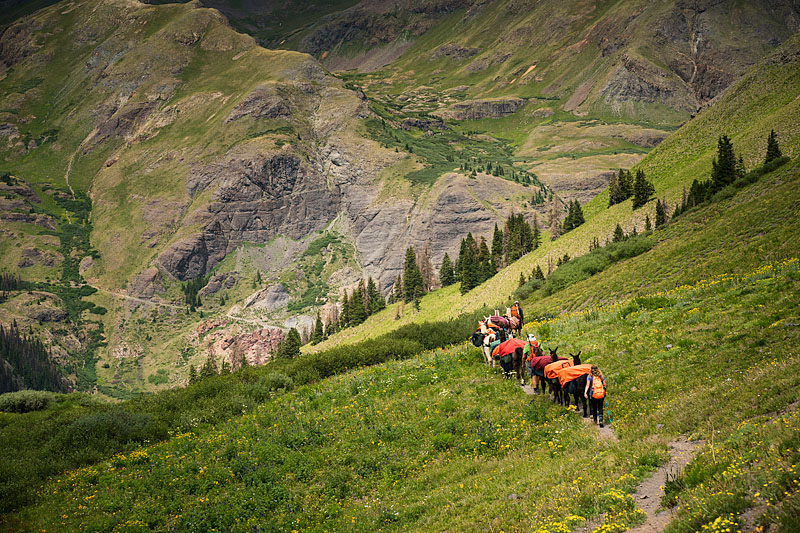
Llama trekking along the Continental Divide Trail
My teenage daughter, Jordan, and I were on a five day guided llama trekking trip through Colorado’s Weminuche Wilderness with Redwood Llamas. We had spent last night at Eldorado Lake, camping in a beautiful valley at 12,500 ft, way up high in the San Juan Mountains. It had been a dramatic night, watching skies produce a pinkish sunset, shooting stars and the Milky Way. (Read Part 1 here and Part 2 here.)

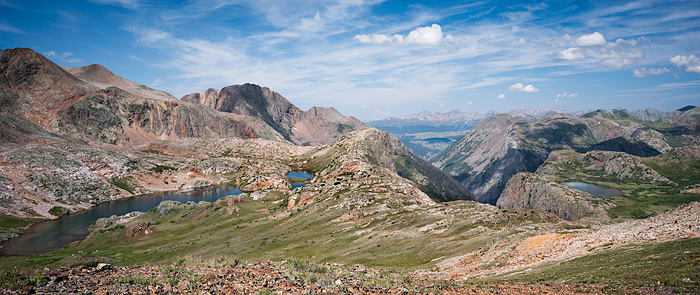
Overview of Eldorado Lake, Weminuche Wilderness, San Juan Mountains, Colorado
Our tent was situated near the smaller alpine lake in the picture above, middle left. Here is a closer look at our camp.

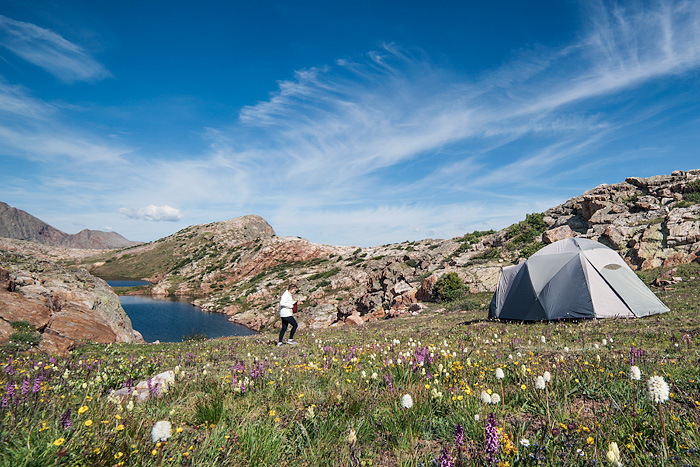
Today, Day 4, of our trip, was a leisurely start since we had a free day at base camp. Over breakfast of eggs, bacon, fruit and coffee or tea, people were discussing how to spend the day. There were options to climb Hunchback Mountain or explore other trails leading to nine different alpine lakes in the Grenadier Mountains.
The sun was out and growing stronger by the minute. It was the only day that it felt HOT. Time to dig out shorts and a tank top. While I was changing into cooler clothes, the group decided to forgo any guided hikes and just trek around Eldorado Lake instead. They were already hiking when I came up to the dining area where the guides were finishing putting things away. Jordan was refilling her water bottle from the filtered system that dripped into a metal coffeepot. Guides Mark and his daughter Amber were planning to explore an old mining site, but offered to take us up Hunchback Mountain—for incredible views of the area—first if we wanted. Sure!
So we grabbed our water and headed up the steep grassy slope following Mark’s lead. Climbing up to a rocky ledge, we came across an old mining shaft. The hole was just one of many etched into the rocks we’d seen scattered around the San Juan Mountains. Seemed like evidence of mining was everywhere we’d been so far in Colorado, from Cripple Creek near Colorado Springs to Silverton, where remnants of rusty mining equipment to eroding wooden structures peppered lands visible from highways to hiking trails. But this was the closest we’d been to a mining shaft, an experimental drilling site where prospectors had hoped to get lucky searching for silver or gold. (Can you spot it? Dark depression in the middle of the frame.)

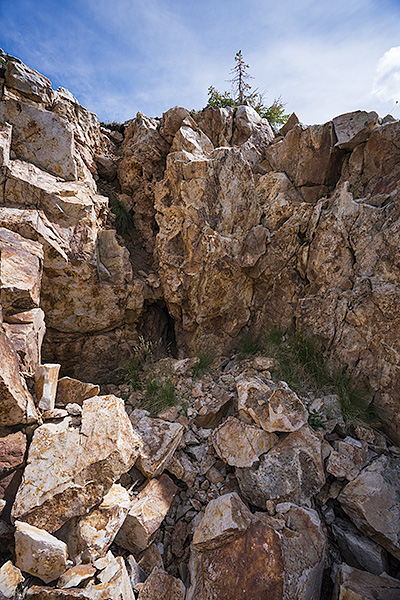 Mark picked up a rock and dropped it into the shaft. A couple seconds later… splash. Not too deep.
Mark picked up a rock and dropped it into the shaft. A couple seconds later… splash. Not too deep.

 There wasn’t much to see except an old crank, so we continued on to the ridge and looked back for a panoramic view of Eldorado Lake.
There wasn’t much to see except an old crank, so we continued on to the ridge and looked back for a panoramic view of Eldorado Lake.

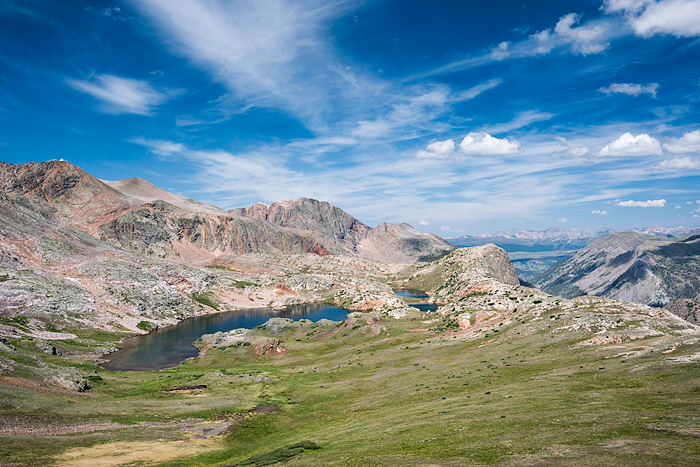
As we headed toward Hunchback Mountain, the trail changed from dirt to shale.
Shale Trail to Vallecito Lake

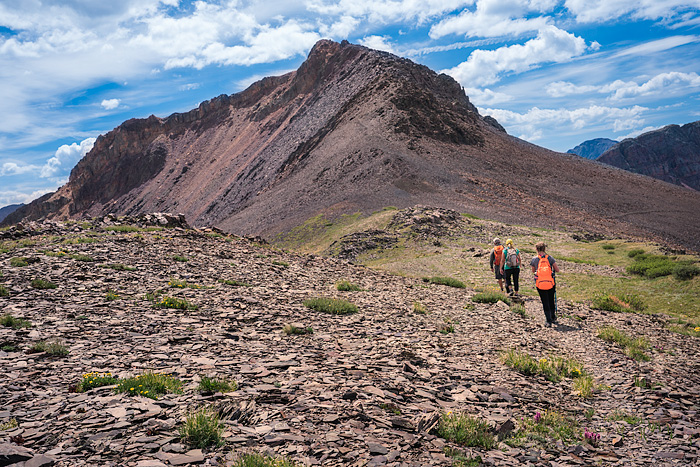 Loose pieces clinked underfoot like fragile glass, yet didn’t shatter when we stepped on them.
Loose pieces clinked underfoot like fragile glass, yet didn’t shatter when we stepped on them.

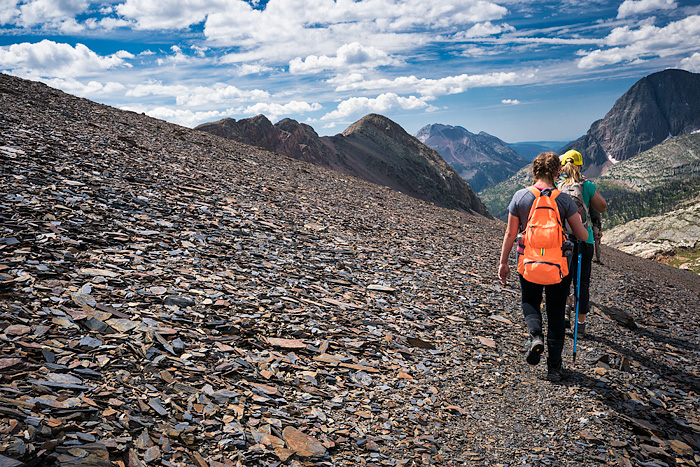 The trail simply became packed, hardened shale along a narrow ridge in the middle of a mountain. Strange!
The trail simply became packed, hardened shale along a narrow ridge in the middle of a mountain. Strange!

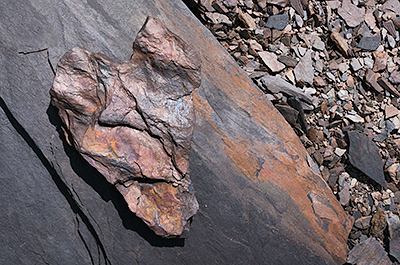
Heart-shaped shale…yes, I love Weminuche Wilderness!
Trekking along the ridge, we came to this scenic spot. Tucked into the base of a volcanic valley in the Grenadier Mountains was Vallecito Lake far below. The icy blue glistened in the sunlight like a sparkling gemstone.

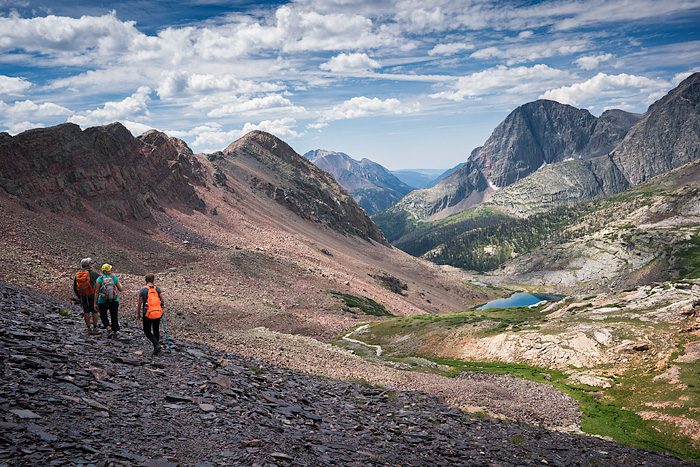
Vallecito Lake and meandering creek, Grenadier Mountains, Weminuche Wilderness
The faint trail leading to the lake, from here, was steep, and descended through loose shards of shale. Wanna hike down? If it were a packed trail it would’ve been a no-brainer. But… sliding through shale was like hiking through scree—one step forward, and sliding two steps back. If the guides needed to be back in a couple hours, I think we’d better pass. Where’s the trail to Hunchback Mountain instead? Mark pointed straight up the shale-covered mountain behind us. I didn’t see an actual trail. Just loose shale. Surely this was a shortcut to the 13,136 ft summit. It didn’t look remotely possible. After a gradual incline, the mountain sharply shot straight up. Ah, no. (Either he was joking, or Mark is part mountain goat.)


We followed Mark back across the shale-covered ridge the way we came, then diverted onto another path that led us past patches of snow and grassy meadows.

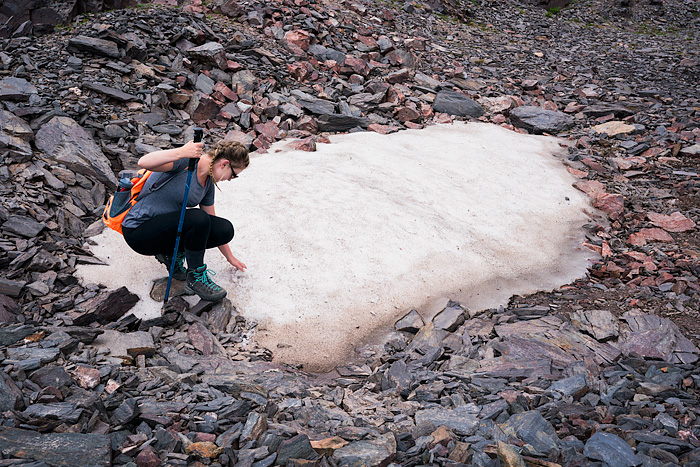 After awhile Mark suggested that we hang with Amber. She could lead us back to camp for lunch while he went on to check out an old mine. Seeing my curiosity, he mentioned that it was located in a steep, treacherous area. (If you think Hunchback looks intimidating…) We hiked with Amber, and Mark disappeared over the ridge to explore the contents of an old mine usually covered in snow.
After awhile Mark suggested that we hang with Amber. She could lead us back to camp for lunch while he went on to check out an old mine. Seeing my curiosity, he mentioned that it was located in a steep, treacherous area. (If you think Hunchback looks intimidating…) We hiked with Amber, and Mark disappeared over the ridge to explore the contents of an old mine usually covered in snow.

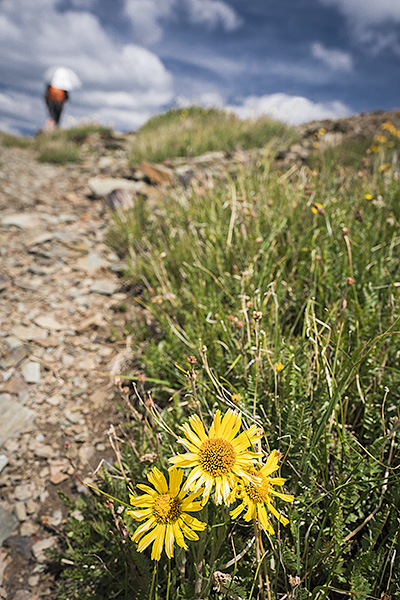
Mark trekking with his umbrella…
The sun was getting intense, zapping our energy to take on any strenuous trails. So we meandered through wildflowers on an alternate way back to Eldorado Lake camp.
Eldorado Lake
Fragrant wildflowers were profuse. Indian Paintbrush, Queen’s Crown and Marsh Marigolds carpeted the valley.

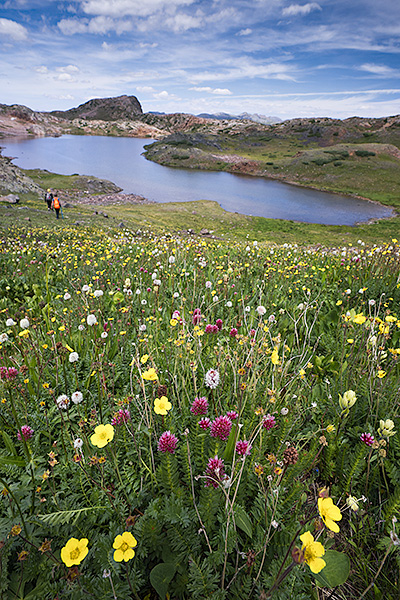 But my favorite views were the alpine lakes nestled in the mammoth mountains, and the shadowy layers of undulating land stretching for miles beyond. Intriguing forms just begging to be explored!
But my favorite views were the alpine lakes nestled in the mammoth mountains, and the shadowy layers of undulating land stretching for miles beyond. Intriguing forms just begging to be explored!

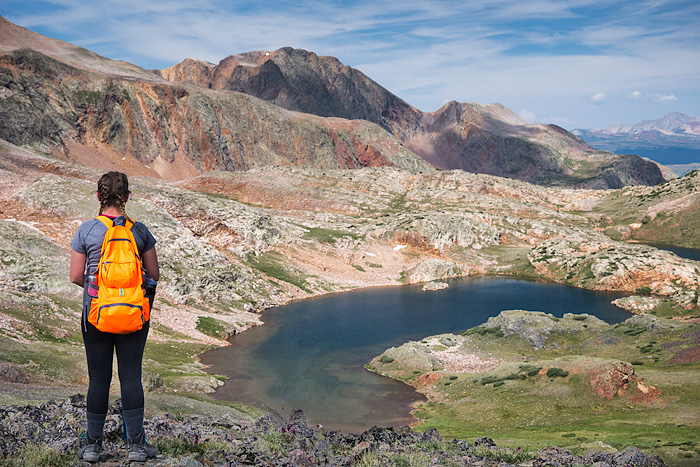 What mysteries, treasures, or bits of history are hidden in the deep recesses of those folds nobody knows. Historical accounts tell of French and Spanish prospectors who traveled through these San Juan Mountains as early as the 1700’s. Their treasure maps and stories-turned-into-legends continue to incite modern adventurers today. But leaves me wondering—what was it like to have traveled through such vast, wild lands back then? What were their stories? I can only imagine the hardships and dual joy—the sense of discovery they must’ve felt trekking through these mountains—and if lucky, their shocked, riotous exuberance finding their pot of gold. But then what? How did they protect it, mine it, haul it out? (I’d love to read their stories—please comment below if you know a good book!)
What mysteries, treasures, or bits of history are hidden in the deep recesses of those folds nobody knows. Historical accounts tell of French and Spanish prospectors who traveled through these San Juan Mountains as early as the 1700’s. Their treasure maps and stories-turned-into-legends continue to incite modern adventurers today. But leaves me wondering—what was it like to have traveled through such vast, wild lands back then? What were their stories? I can only imagine the hardships and dual joy—the sense of discovery they must’ve felt trekking through these mountains—and if lucky, their shocked, riotous exuberance finding their pot of gold. But then what? How did they protect it, mine it, haul it out? (I’d love to read their stories—please comment below if you know a good book!)

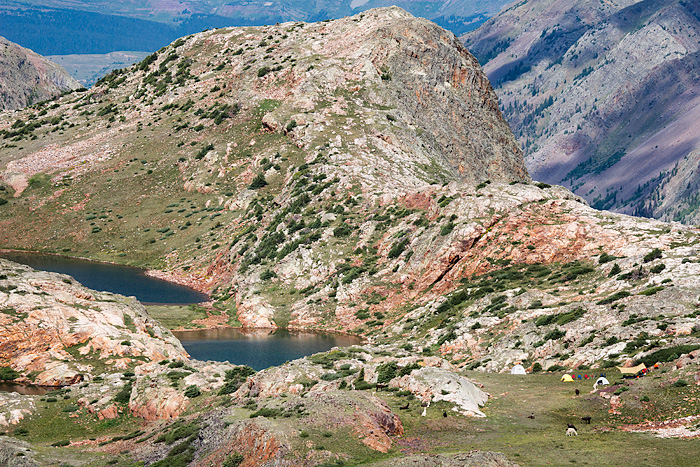
Our camp visible on the right

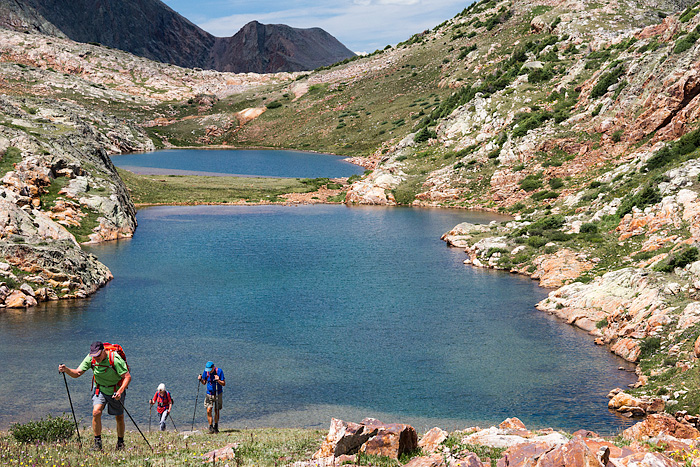
When Jordan and I reached our tent, we saw the other hikers in our group ascending the grassy slope from Eldorado Lake. They’d just finished trekking a long loop, climbing on rocks around the combined lakes. Hot and sweaty, we all collapsed into our camp chairs while Amber & Sam prepared our lunch and llamas grazed on grasses around us.
That afternoon everyone spread out to enjoy some solitude in the stunning landscape. Jen sketched in her notebook. Randy read. Barb found a quiet spot on a high rock. Amber dipped her toes in the cool lake water. Sam wandered out of view around the lake. Jordan journaled. I grabbed a notebook and sat on a rock by some rusty mining equipment at the foot of the lake where I noticed another mine shaft in the rocks across the creek. Nobody felt like hiking in the intense heat of the beating sun. I washed my hair in the lake to cool off and shed my boots. Then took a sponge bath with filtered water using the portable plastic sink they provided for each tent. Mellow downtime to just chill felt great after 3 days of moderate-strenuous trekking.

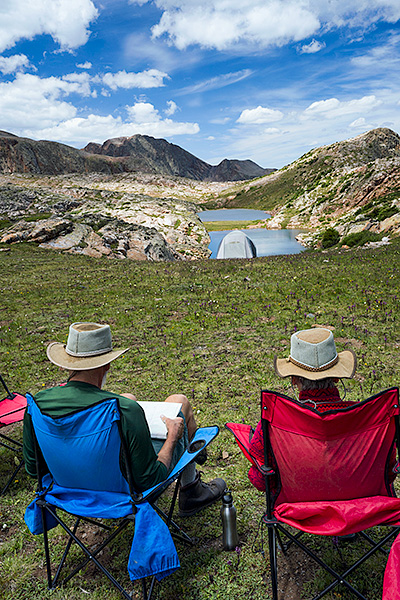

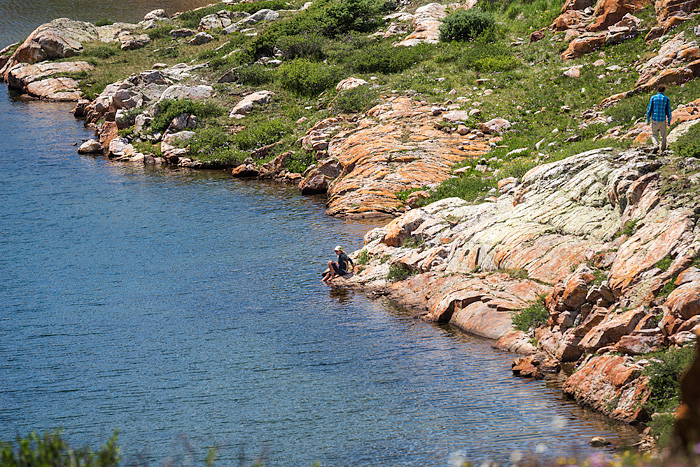 Gradually we all congregated around the dining area when word spread that fresh guac, chips and salsa were ready in the late afternoon. We hung out there till dinner. Conversation came easy on our last night together. Our small group of 10 (2 couples, a single man, me and my teenage daughter, and our 3 guides ranging from 20’s-50’s), by now felt like old friends. On the menu tonight was fajitas–lamb, pork and chicken, peppers, onions, tomatoes, black beans, tortillas, salad, and chocolate cake with whipped cream for dessert.
Gradually we all congregated around the dining area when word spread that fresh guac, chips and salsa were ready in the late afternoon. We hung out there till dinner. Conversation came easy on our last night together. Our small group of 10 (2 couples, a single man, me and my teenage daughter, and our 3 guides ranging from 20’s-50’s), by now felt like old friends. On the menu tonight was fajitas–lamb, pork and chicken, peppers, onions, tomatoes, black beans, tortillas, salad, and chocolate cake with whipped cream for dessert.
All at once someone noticed a deer approaching the llamas beyond the dining area. Curious guy!
I ran to the tent to grab my camera and long lens. When I returned, he was really close. And just staring at Drake. Neither animal moved.

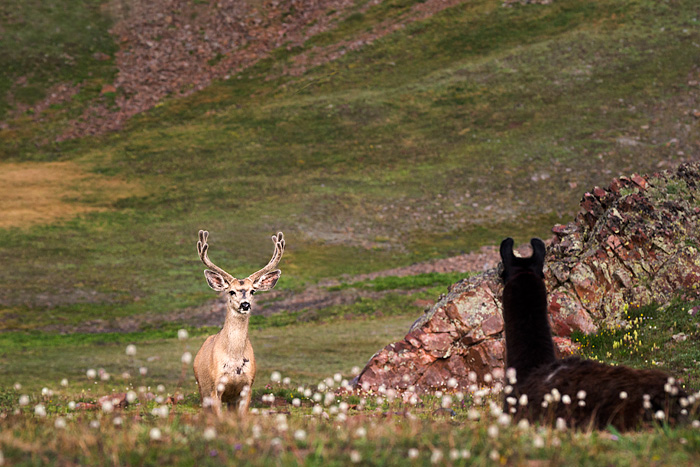
I clicked a couple shots at 300mm before he jumped away. Moments later he appeared on top of a tall rock for another view of the seemingly strange creatures we call llamas. Jordan noticed a couple more deer up on the ridge, a half mile from camp. Their silhouettes were far away now, but they could move here in minutes.
Mark told us stories about the mountain goats who did the same thing last year. The animals had been up on the ridge one minute. Then appeared on the rocks surrounding camp the next. After watching the llamas and campers from their perch for awhile, the mountain goats nimbly climbed down to ground level and were curiously approaching…with amazing speed. But the llamas scared them off.
There was one particular family of mountain goats who roamed this region regularly. Past groups had reliably seen them while hiking on day trips from Eldorado Lake. But nobody had sighted them this year. Guides thought that was odd.
Skies darkened with ominous-looking clouds. Rain was on its way. Amber & Sam were busy moving the llamas to fresh pastures. Many of us jumped up to mingle with the llamas before we retired to our tents. Jordan led her favorite llama, Zeus, around before bringing him to newer pastures. It was the perfect time to take a few shots for her senior pictures—nope, no glamour here —just natural joy. Let happiness shine!
Llamas…those ears!

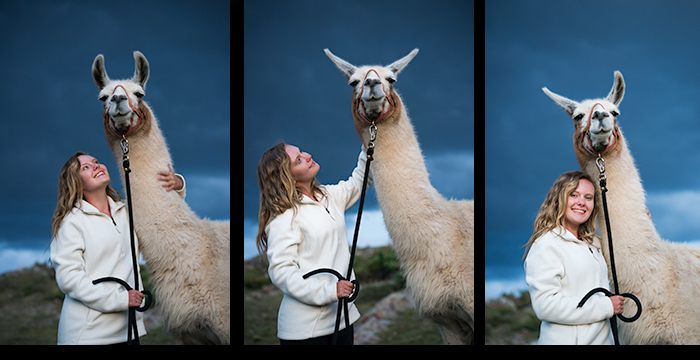
Zeus demonstrates the distinctive ear formations llamas use to communicate (along with my own interpretations)—upright (happy), Yoda (curious) and the swivel pose (completely bewildered)
Goodnight, llamas!

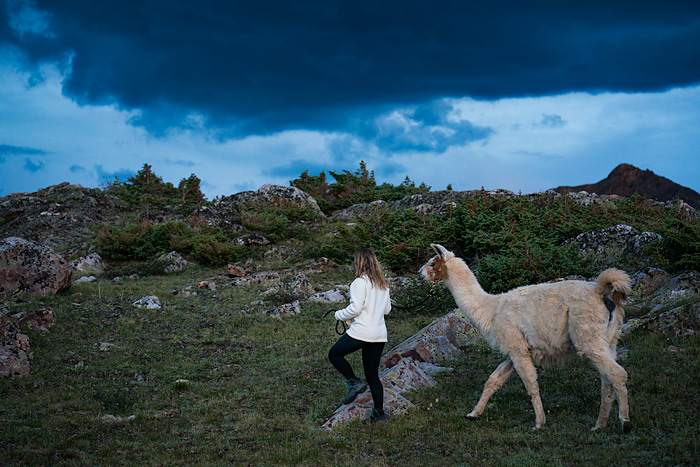
That evening brought rain and intense winds. Our tent rattled and shook. Strange huffing and snorting noises were bothersome too. Numerous times I was convinced there must be an elk or deer breathing loudly outside our tent. I remembered spying a little baggie with trailmix outside the flap before we went to bed. Did Jordan ever put it away? Or was it drawing animals? When I imagined that an elk was nudging the metal poles, and not the wind, I actually called out to it, “Just leave!” Twice more I got out my flashlight and unzipped the flap to see what animal was surely there. But the blackness of the pitch dark night stared back. It was just the wind.
Trying to ignore the heavy breathing of imagined elk, deer or mountain goats, I laid in my tent reminding myself, and my brain, that llamas were nearby. Llamas are a great guard animal to have around. They produce a shrieking alarm if they spot any wildlife lurking about. Their distinctive alarm cries can even scare off bears.
The next morning, Barb, from the next tent over, commented that she heard the ruckus rattling our tent. Apparently we had not only erected our tent on a slope but had also selected a wind tunnel. The eerie noises—and my vivid imagination— had kept me awake a lot of the night.
It didn’t help listening to Mark and Amber’s stories about the mountain goats who approached camp a little too closely last summer. Or to have witnessed the deer with a full rack of antlers suddenly appear in camp to curiously confront the llamas earlier that evening. We were in a wilderness where wildlife was—well, wild.
Day 5
The next morning everyone awoke early. We began breaking down our tent at 6am, but were clearly not in the lead. Dave was already packed up, and the 2 couples were busy taking apart the poles of their tent. And Amber was bringing llamas two at a time down to the lake to hydrate before our journey.

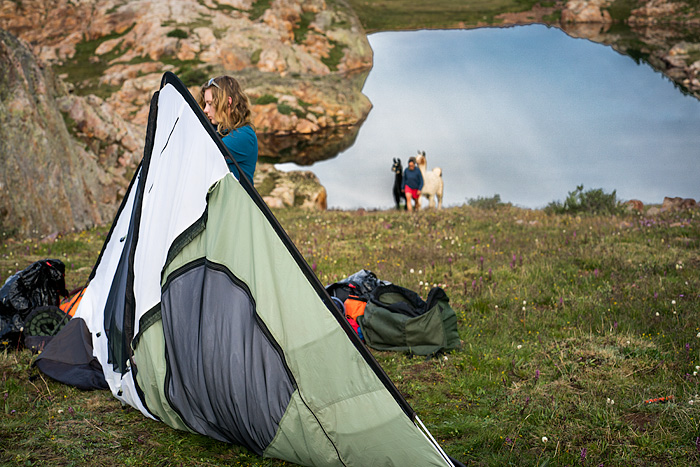

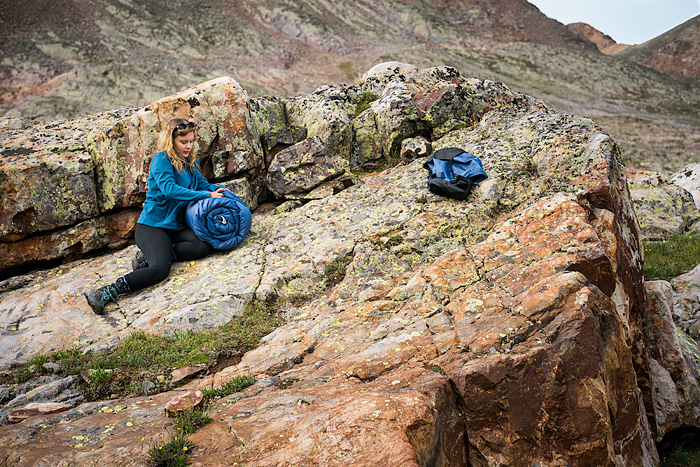
Today would be our longest hike, around 9.5 miles, back to Cunningham Gulch where we began. The guides had set out yogurt, granola, nuts and fruit for breakfast on a rock for us to grab at our convenience while we folded up our tents and loaded up our panniers for the llamas. The guides were busy breaking down the rest of the camp, carefully weighing and balancing the loads for the llamas to haul out.
As people finished bringing packed panniers up the hill to the guides, they began the half mile hike up to the ridge. We were to hike on ahead of the guides and down the rocky section the way we hiked in. The guides and the llamas would catch up to us quickly. We all departed in staggered positions, the last to leave at 7am. The 30 minute half-mile hike up to the ridge was oddly the hardest part of the day. I was glad that we only had to wear a lightweight day pack to carry our rain gear, snacks, water and camera gear. The llamas were carrying the bulk of everything, from our clothing, tents, food, table, chairs and even my spare camera, extra lenses and tripod. Thank you Zeus!
Since I had used my 16-35mm lens on my Sony a9 camera body during the hike to get here, I decided to use a different lens to get another perspective. (I don’t like changing lenses on the move, but do carry an alternative in my daypack just in case….) So today I would be shooting with a fixed lens, my Zeiss 85mm, f1.8. With less flexibility than a zoom, it would force me to approach or distance myself physically with my feet, and make me focus on scenes farther away.
Once at the top of the ridge, we hiked the familiar path that led to the talus slope.

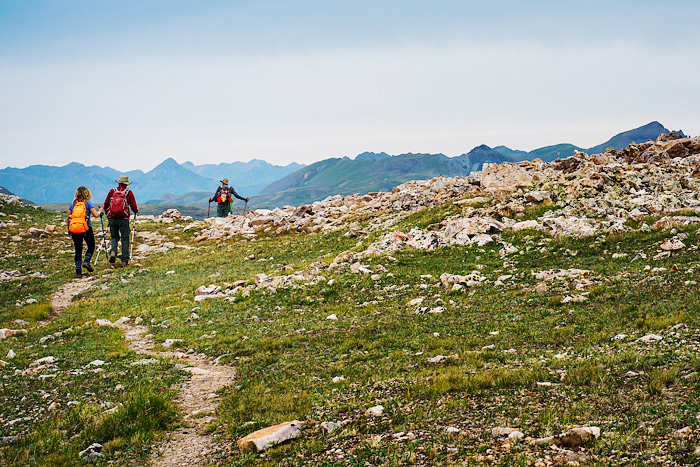 Talus Slope
Talus Slope
The trail descended through the talus, large chunks of rocks eroding from the mountain slope. Other than a few loose rocks, the trail was packed and firm with no gravelly scree. Views were spectacular as we wound down the slope in zigzag fashion.

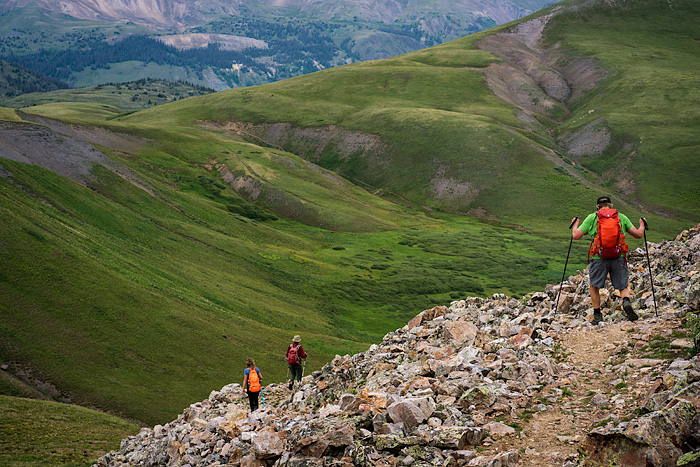

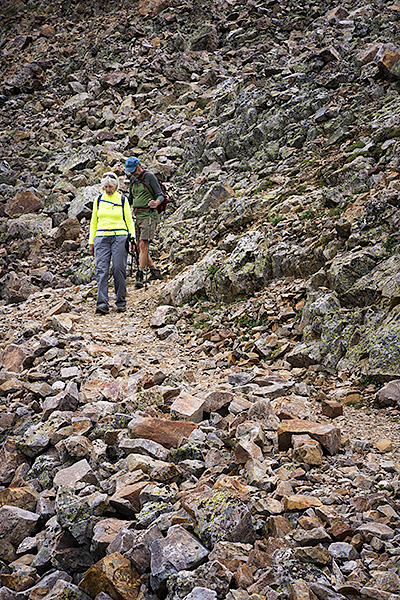
Barb and Phil nearing the end of the talus slope.
Once we all made it down, we dispersed to explore the immediate area while waiting for our guides and llamas. Dave laid in the grass to photograph wildflowers, others captured the scenery and an old mining cabin nestled in a verdant valley.

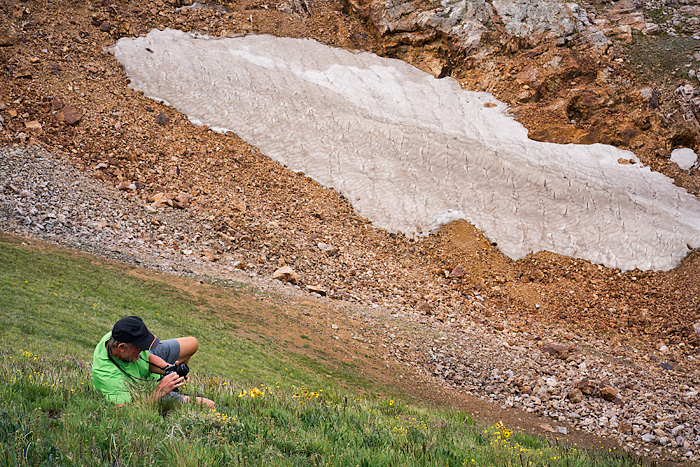

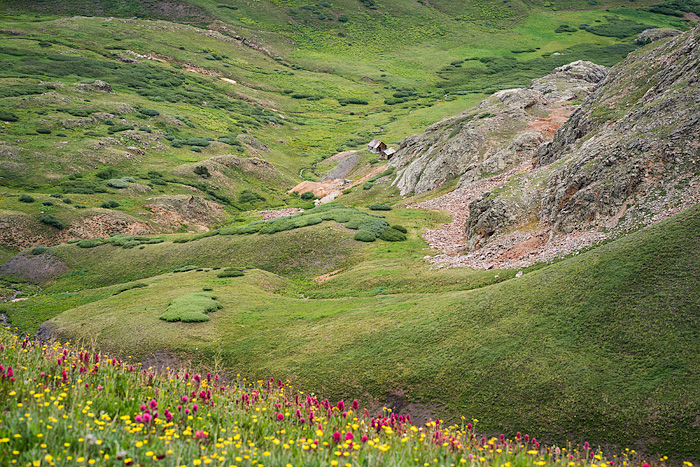
Old miner’s cabin near rock outcroppings

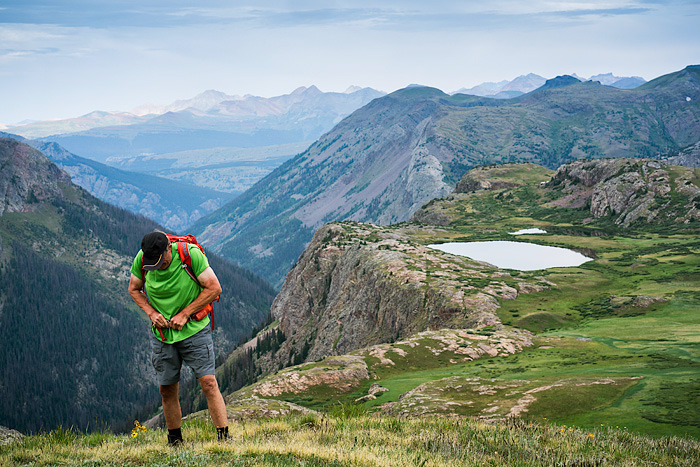 “Hey! Here they come!!” someone yelled. The llama train was coming down the talus slope. Time to put our daypacks back on. They’d be here momentarily!
“Hey! Here they come!!” someone yelled. The llama train was coming down the talus slope. Time to put our daypacks back on. They’d be here momentarily!

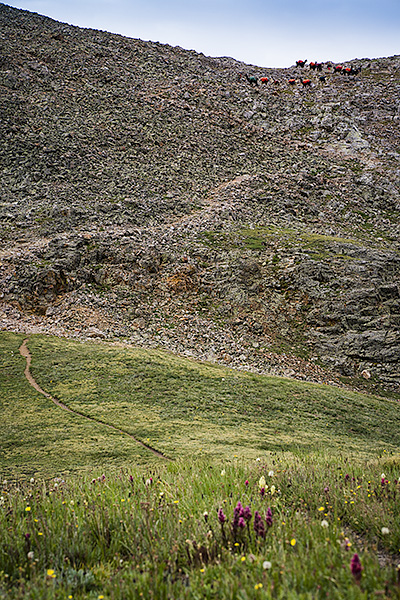 Wanna guess how long it took them to come down that rocky path?
Wanna guess how long it took them to come down that rocky path?

 From the tip top to the bottom of the rocks… just three-and-a-half minutes!
From the tip top to the bottom of the rocks… just three-and-a-half minutes!

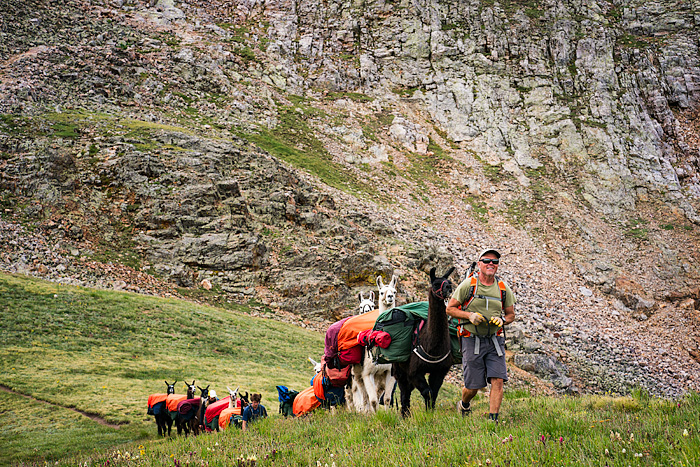
Yep, those llamas are fast. We, for comparison, took ten minutes. Which isn’t bad considering the scope of that slope! Going down was obviously much faster than going up (and far less effort).
Our speed made me realize how fast we’d cover our long distance of 9.5 miles today since we’d be losing elevation the whole way. We would be hiking from camp at 12,500 ft to Cunningham Gulch trailhead at 10,460 ft.

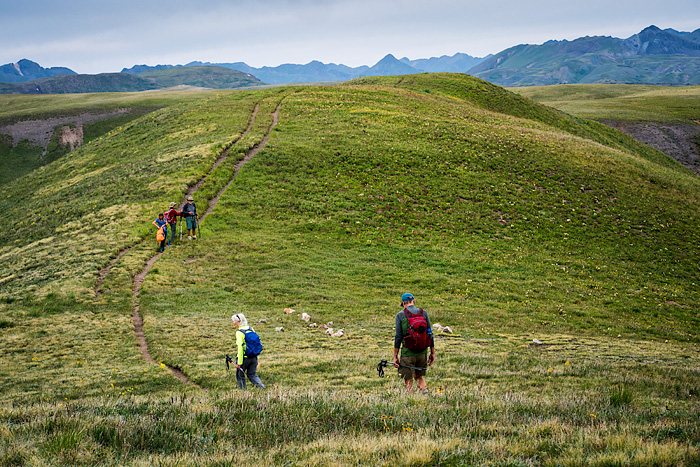
We followed the llamas across the grassy meadows for about 30 minutes on this stretch before we connected to the Continental Divide Trail.

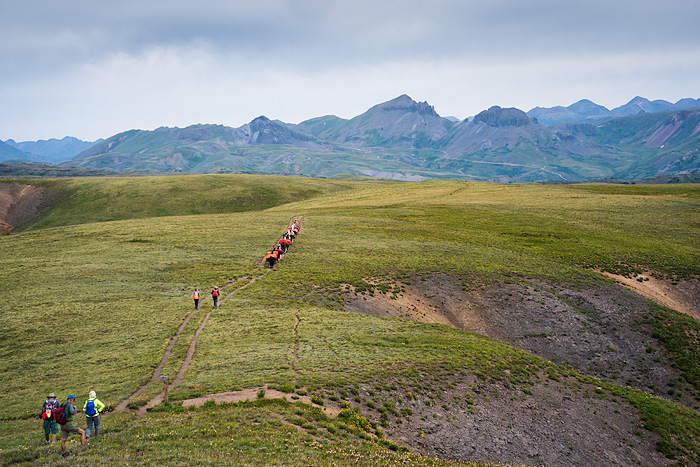
Ok, so it wasn’t all downhill!

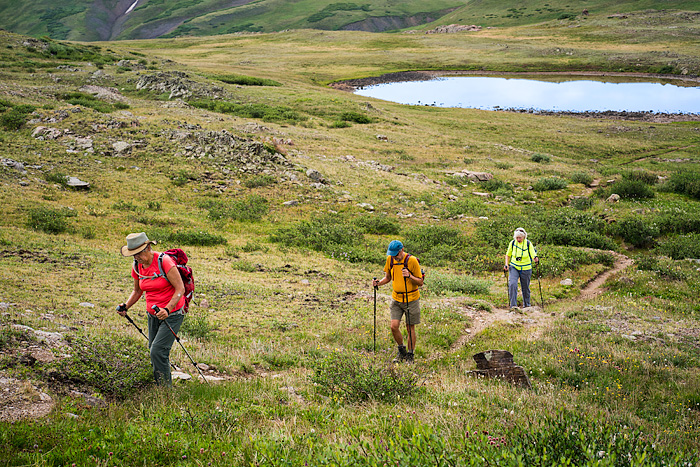 Yay! We made it to the high point of the Continental Divide…
Yay! We made it to the high point of the Continental Divide…

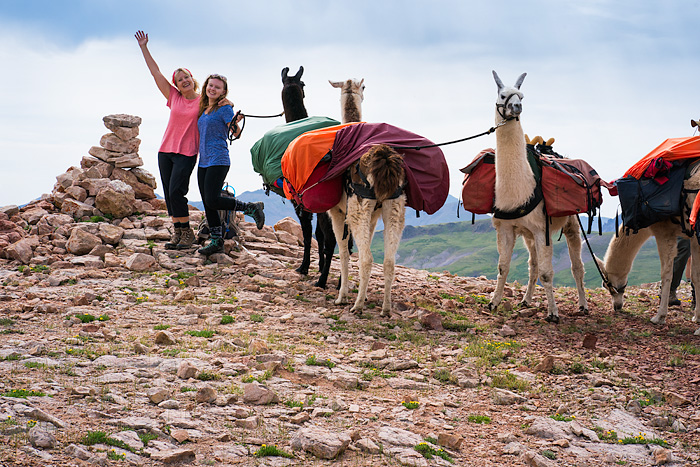 During our short rest break, Amber offered trailmix, beef jerky and candybars while we hung out with our llama buddies. Jen getting a birthday kiss?
During our short rest break, Amber offered trailmix, beef jerky and candybars while we hung out with our llama buddies. Jen getting a birthday kiss?

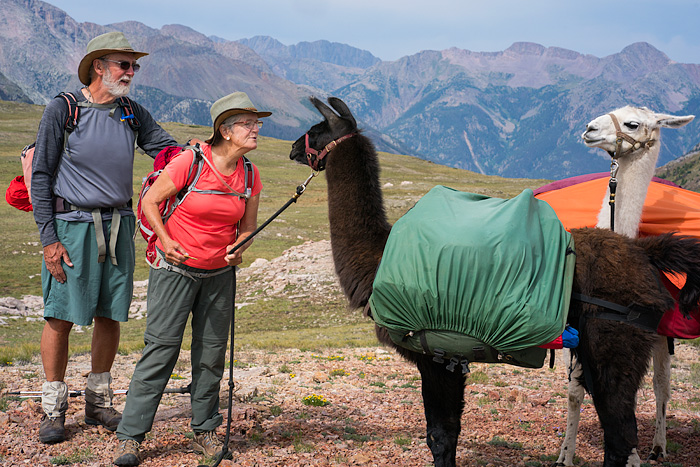

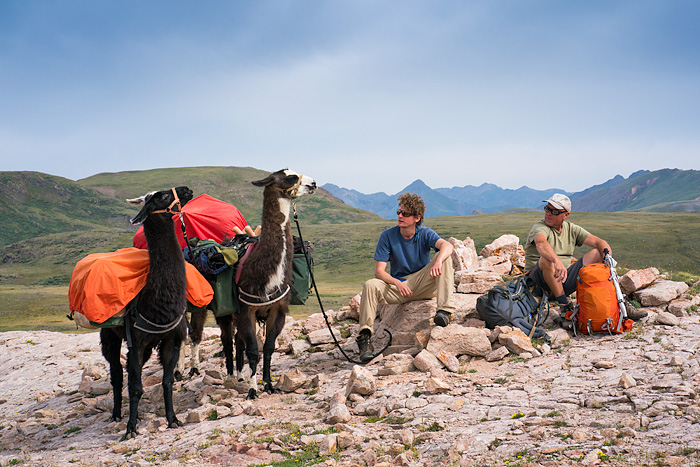
Notice the ear position on the llamas? Ears straight back meant that they were agitated. Despite being docile most of the time, certain juvenile males clashed. When irked to a high degree they will spit at one another. I never saw any spitting on this trip. I like how Sam & Mark are watching them—what are the boys fired up about?
As we prepared to leave, the guides asked if anyone else wanted to lead some llamas. So far Jordan was the only one who’d volunteered. Dave was a strong and fast hiker and could easily keep pace with them. So he picked up the lead rope and led the way with a trio of black llamas (forgive me Jordan, I forgot their names!)
Continental Divide Trail

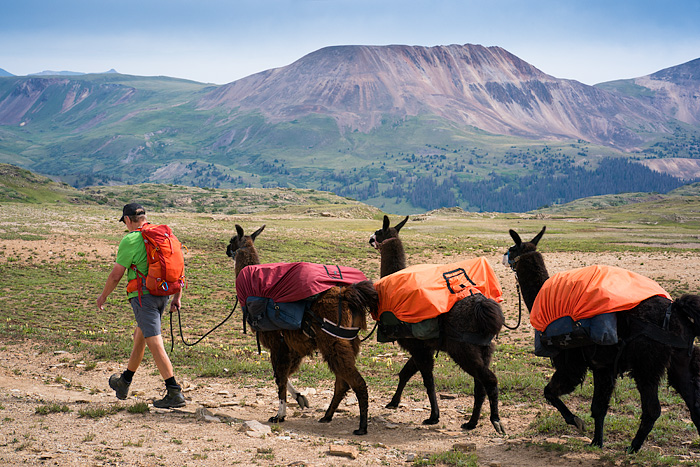
As we hiked along, Dave broke into song…”Edelweiss Edelweiss…Every morning you greet me…Small and white…Clean and bright….You look happy to meet me…” The lyrical music from the Sound of Music resonated beautifully in this mountainous setting. The haunting tune stayed with me long after he stopped singing. It seemed perfectly fitting. Thanks, Dave!

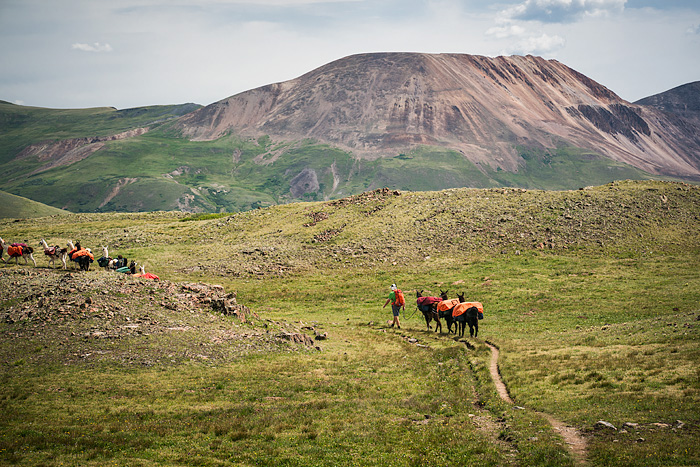

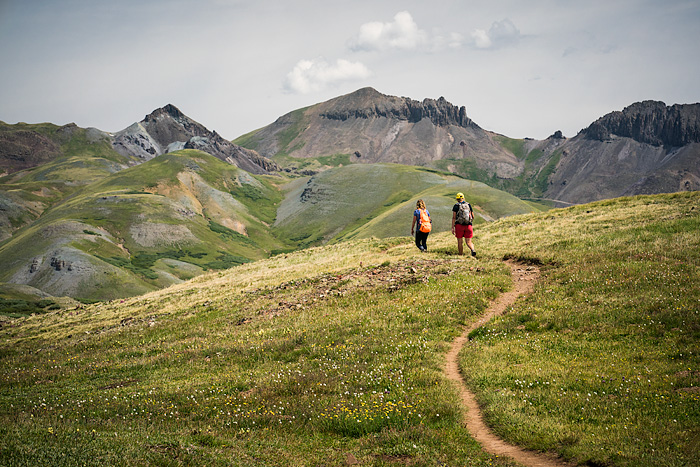 Our journey took us through familiar scenery for awhile. But instead of going back by Highland Mary Lakes we took another route toward Cunningham Gulch, and stayed on the Continental Divide Trail most of the day. The trail was easy to follow. And easy to walk on with no willows, rocky talus, loose gravel or scree. And the scenery? Simply amazing.
Our journey took us through familiar scenery for awhile. But instead of going back by Highland Mary Lakes we took another route toward Cunningham Gulch, and stayed on the Continental Divide Trail most of the day. The trail was easy to follow. And easy to walk on with no willows, rocky talus, loose gravel or scree. And the scenery? Simply amazing.
Our last lunch stop of the trip was early, around 10:30am. But we had been on the trail since 7am. We snacked on crackers & cheese, and peanut butter & jelly sandwiches while talking about meeting up in Silverton when got back to town for a celebratory drink.

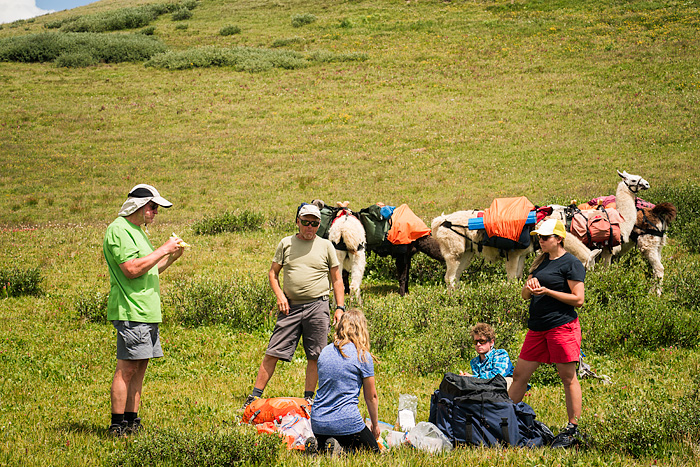 We were making good time, and would reach the trailhead sooner than the mid-afternoon target. We filed into line behind Mark leading the llama train…
We were making good time, and would reach the trailhead sooner than the mid-afternoon target. We filed into line behind Mark leading the llama train…

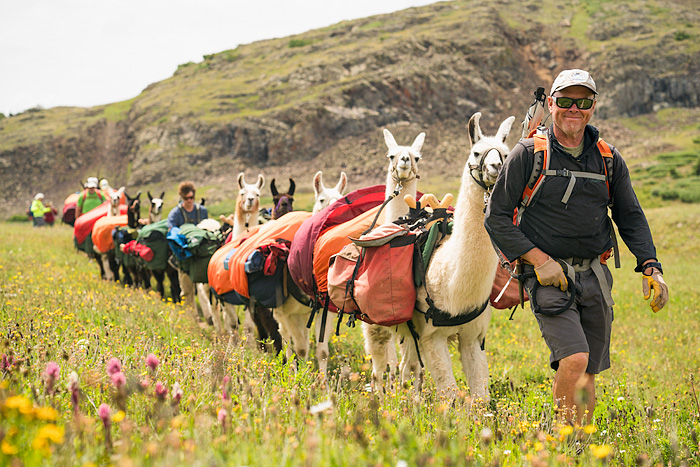 This entire llama trekking adventure through the San Juan Mountains had exceeded my expectations in every way. Who knew that Colorado had such stunning scenery? It was nothing like I remembered having traveled through as a kid. I was blown away. Every day.
This entire llama trekking adventure through the San Juan Mountains had exceeded my expectations in every way. Who knew that Colorado had such stunning scenery? It was nothing like I remembered having traveled through as a kid. I was blown away. Every day.

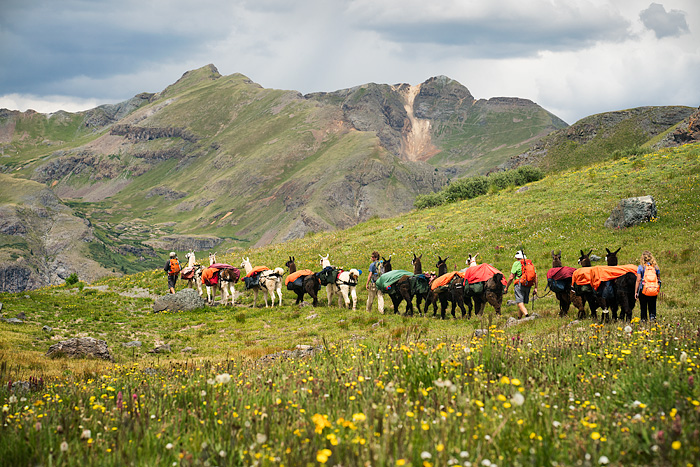


A little past here we came to a creek where 2 of our guides, Mark & Sam, parted with the llamas to hike ahead. Amber stayed with the rest of the group and led us on a spur trail to Cunningham Gulch. Goodbye Continental Divide!

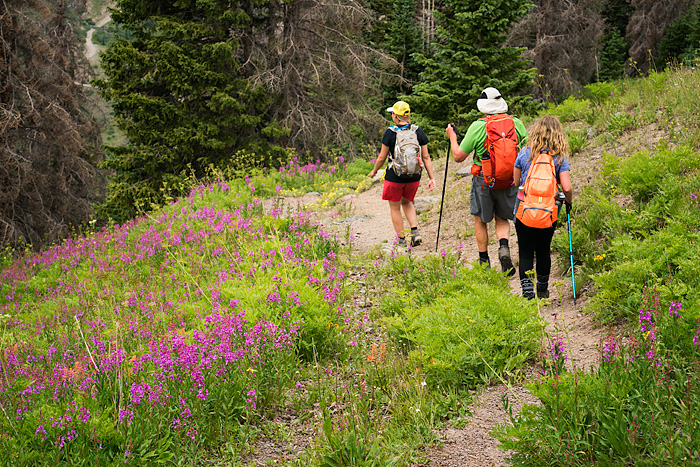 The blooming purple Fireweed was a stark contrast to the dry feathery Spruce trees that were dying from beetle infestation.
The blooming purple Fireweed was a stark contrast to the dry feathery Spruce trees that were dying from beetle infestation.

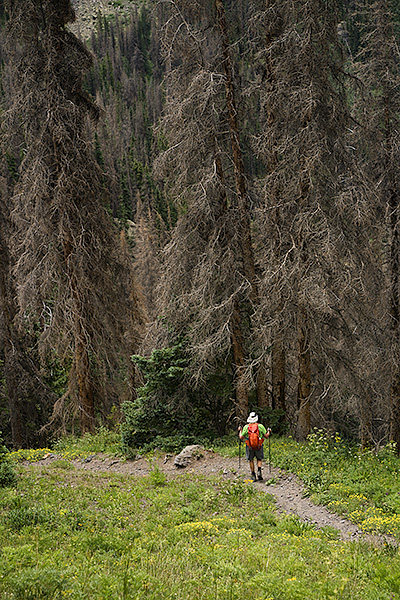
Our group hiking through wildflowers…

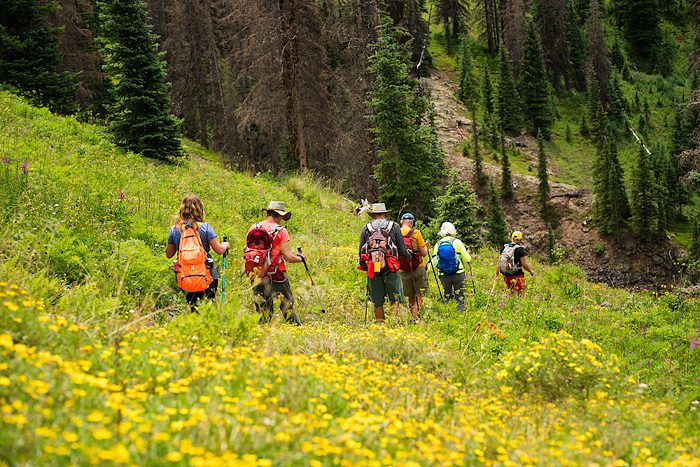

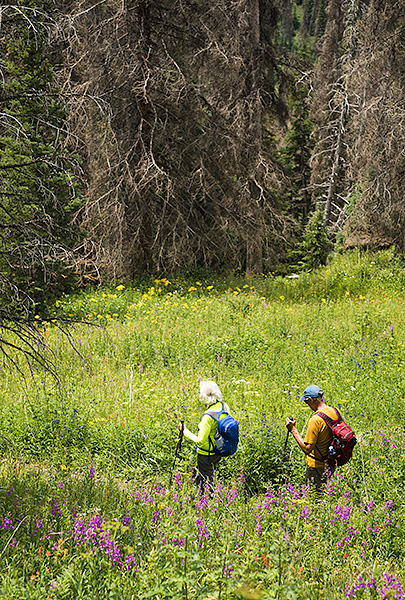
The dying spruce trees are a threat in the severe drought the western US is experiencing. Wildfires have been rampant this year. San Juan National Forest made national news when it was closed down for the first time in its 113 year history. The “416 Fire” that began June 1st in the forest near Hermosa, north of Durango, spread quickly and forced the evacuation of 2,000 people from their homes, the closure of Highway 550 (only road between Silverton and Durango) and the tourist train. On June 12th, the decision to close the 1.8 million acre San Juan National Forest went into effect. No one was allowed to enter the park. Not even for day hikes.
The 416 Fire burned 26,500 acres before rains brought it to an end. The forest was re-opened on June 20th. Seeing pictures online of the destruction and orange tinted atmosphere from that time was alarming as hikers shared their stories. I knew that the fire hadn’t reached the Weminuche Wilderness where we had been hiking this week, but hadn’t expected such clear, untainted skies just a month later in mid-July.

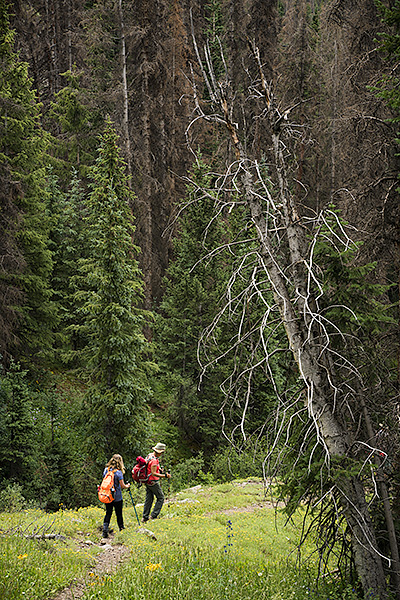 By noon we were crossing the stream where we began our journey 5 days earlier, using our hiking poles for balance as we stepped on fallen branches to protect our boots. From here it was a short 15 minute hike to the trailhead at Cunningham Gulch, where Redwood Llamas owner, Bill Redwood, and our guides were waiting for us with the llamas already loaded into the trailers.
By noon we were crossing the stream where we began our journey 5 days earlier, using our hiking poles for balance as we stepped on fallen branches to protect our boots. From here it was a short 15 minute hike to the trailhead at Cunningham Gulch, where Redwood Llamas owner, Bill Redwood, and our guides were waiting for us with the llamas already loaded into the trailers.

 Looking down at the trailhead, it felt strange to see cars and ATV’s after being in the wilderness. And bittersweet. I really wasn’t ready for this experience to end.
Looking down at the trailhead, it felt strange to see cars and ATV’s after being in the wilderness. And bittersweet. I really wasn’t ready for this experience to end.

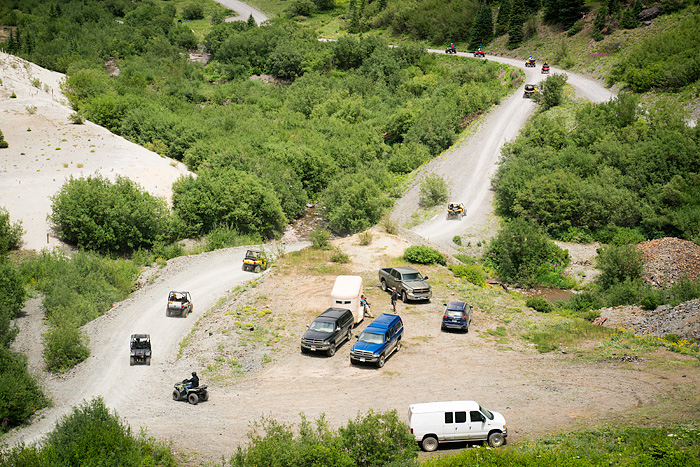
We drove back to Silverton, reclaimed our cars at Bill’s house and headed to a local pizzeria to hang out just a little longer. It was a great finish to our trip— spending time recapping our adventures with one another, including our guides and Bill, the Redwood Llamas owner and organizer of our llama trekking in the beautiful San Juan Mountains. Cheers!
~~~~~~~~~~~~~~~~~~~~~~~~~~~~~~~~~~~~~~~~~~~~~~~~~~~~~~~~~~~~~~~~~~~~~~~~~~~~~~~~~~~~~~~~~~~~~~~~~~~~~~~~~~~~~~~~~~~~~~~~~~
Redwood Llamas offer 11 different guided llama trekking trips from July to September, including some just for 11-13 year olds. (Now that would be an awesome summer camp!) They also offer llama leasing for those who want to hike and camp on their own. This 3 part post was about our experience on the Weminuche Wilderness Trip 7 from Highland Mary Lakes to Eldorado Lakes. Which you know by now, I highly recommend!!
For my trip tips about altitude, clothing and camera gear see Part 1.


